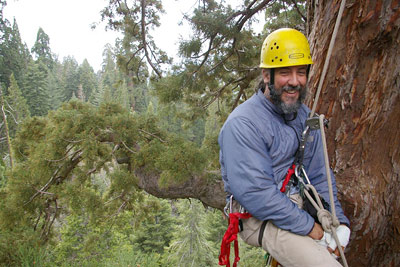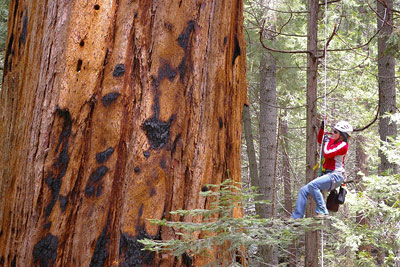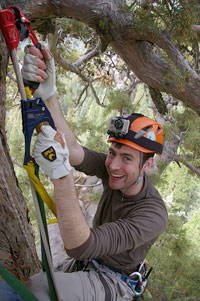Cornellians are first to climb giant sequoia to collect seeds
By David Katz


Eight Cornell students climbed more than 280 feet high into the canopies of giant sequoia trees during the first "Redwoods Tree Climbing" course offered by Cornell Outdoor Education, May 22-29.
"It was an amazing experience to become one of so few people who have climbed to the top of a giant sequoia tree," said Tara Ostock '13.
The focus of the course was to teach students how to safely climb into tree canopies and contribute to ongoing research in the old growth giant sequoia forests of the Sierra Nevada.
The course began in April in the hardwood forests near Ithaca for basic climbing training. The course's five instructors used a skill-based progression to teach the students to ascend into (and sleep overnight in) the tops of the old growth trees. Four in the group were the first ever to climb one particular giant sequoia -- 260 feet tall -- one of the world's tallest trees. Three instructors climbed to the top of another tree -- 306 feet tall, just 4 feet shorter than the world's tallest sequoia -- to harvest seed cones.
"Learning the tree techniques to reach the top of a tree no one had ever climbed before was a fantastic goal to accomplish," said Ryan Bishop '12. "I was surprised to discover different organisms living at the top of the sequoia than on the ground we left just hours ago."
"Giant sequoia is a challenging species to climb as often the first safe branches to tie onto are over 200 feet above ground," said Robert Moore '12, an instructor for the course. "We have adapted our techniques for getting our ropes into the tree by using large slingshots and crossbows that launch weights and trail a strong and lightweight fishing line. These lighter weight lines enable us to haul our climbing lines high into the canopy from the ground and lower branches."

Last year, climbers from the Cornell Tree Climbing Institute traveled to the Sierra Nevada to begin a research collaboration with the University of California-Berkeley (UCB) Center for Forestry and the California Department of Forestry and Fire Protection (CAL FIRE). The ongoing project involves collecting seed cones from the upper canopy of old-growth trees that are more than 250 feet tall. The climbers' skills were put to the test as many of the seed cones lay on the outer tips of the brittle branches. Through innovation and practice, the climbers collected more than 20 bushels over the course of a week of collection.
Back on the ground, experts from the Los Angeles Moran Reforestation Center in Davis, Calif., and UCB supervised the initial processing of the seed cones. The collected seed cones were then transported under controlled conditions to Davis where the seeds are to be extracted from the cones and where genetic research on viability of seed germination is to be conducted. Additional seeds are stored in a refrigerated CAL FIRE Seed Bank and saved for future plantings of new seedlings for reforestation efforts in upcoming years.
The Cornell Tree Climbing Institute publishes a tree-climbing manual and offers instructional videos on recreational tree climbing gear and techniques at http://www.treeclimbing.coe.cornell.edu.
David Katz is a climbing instructor with the Cornell Tree Climbing Institute.
Media Contact
Get Cornell news delivered right to your inbox.
Subscribe